Birding Hotspot: U.C. Botanical Garden
This is the third in a series of occasional reviews of Bay Area birding locations. Do you have a favorite site you’d like to share? Email idebare@goldengatebirdalliance.org.
By Chris Carmichael and Phila Rogers
Strawberry Canyon has it all – a vigorous year-round stream, lush riparian vegetation that follows the stream, and surrounding hillsides with native coastal chaparral and open grasslands.
The U.C. Botanical Garden, located on 36 acres at the upper end of the canyon, features not only the stream and the riparian habitat but extensive collections of plants from around the world.
The Garden, with its shady glens and open hillsides, has attracted birders almost from the time it moved up into the Canyon in 1923 from its original home at the west end of the Berkeley Campus. Its publication, “Birds of the UC Botanical Garden,” lists 100 species, many of which are year-round residents. Others are seasonal residents, and some are casual visitors.
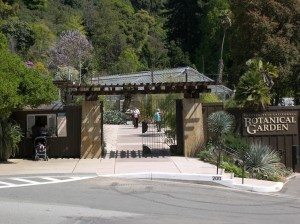
Every season offers its pleasures. In the winter, the garden is full of wintering sparrows along with Hermit Thrushes, Ruby-crowned Kinglets, and gaudy Red-breasted Sapsuckers. Most winters, Varied Thrushes can be heard and sometimes seen in the denser areas of the Garden.

In the spring, the canyon and the garden resound with glorious songs from breeding singers like Black-headed Grosbeaks, Warbling Vireos, and the Pacific Wren. Partial songs of Fox Sparrows and Hermit Thrushes can be heard briefly before they leave for their summer haunts.
For at least the last decade, the Garden has had its own Red-tailed Hawk – an unusual partial leucistic bird with a white mantel and a pale breast. Seen year-round, it is easily identifiable as a distinct individual. Most years, it is paired with a normal colored morph.
Along with welcoming a steady stream of birding visitors, many with cameras in addition to binoculars, the Garden offers quarterly Saturday morning walks co-led by Chris Carmichael, associate director of horticulture and collections, himself an avid birder. Golden Gate Bird Alliance member Phila Rogers was asked to step in as a co-leader when expert birder Denis Wolff moved to Oregon.
Even if birding is slow, Chris, with his deep knowledge of plants, has wonderful stories to tell, rich with examples of how the local native birds have adapted to exotic plants.
“Certain plants seem to act as a bird magnet,” Chris explains. “One such plant is the honey bush (Melianthus major) growing in the South African area. The dark maroon blossoms of this plant are favored by nectar feeders such as Hooded Orioles who come to the Garden each spring. But I’ve also seen Ruby-crowned Kinglets, Townsend’s Warblers, Dark-eyed Juncos, Song Sparrows, California and Spotted Towhees, Steller’s Jays, and Black-headed Grosbeaks visiting the melianthus as well.
“The Garden’s rich floral display yields hummingbirds year-round,” continues Chris. “Both Anna’s and Allen’s Hummingbirds are breeders, with Rufous Hummingbirds coming through during migration. The Rufous Hummingbirds have been known to spend the winter, often favoring flowers in the Mexican and Central American Areas, including salvias, penstemons, and the vining Peruvian Lily relative, Bomarea.
“Hooded Orioles, who arrive in the spring, nest in the palms in the Cycad and Palm Garden which surround the Conference Center. They generally choose one of the many fan (in contrast with feather) palms. They are clearly adaptable, choosing non-native palms, as our specimens of native Washingtonia filifera are still too small to host nesting orioles.”
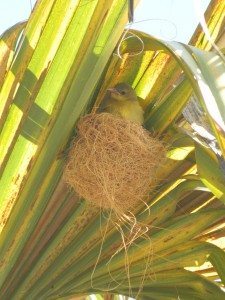
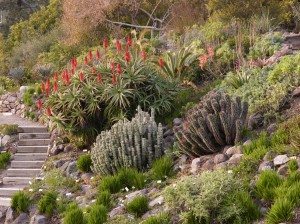
Chris points out that: “not surprisingly, certain native bird species favor Garden areas that correspond to their natural habitat. Wrentits, California Thrashers, and Scrub Jays are most commonly seen in the far upper reaches of the Garden, closest to coastal scrub growing outside the fence line. Just within the Garden, the macquis habitat of the Mediterranean Area is sometimes considered to be ecologically comparable to the chaparral habit of California. Similiarly, within the Garden’s collection, Brown Creepers and Hermit and Varied Thrushes are frequently encountered in the densely-wooded parts of the Asian and Eastern North American Areas.”
This year in April, GGBA and the Garden hope to co-sponsor our second annual bird sit, with an emphasis on quiet listening – not only to individual bird songs and calls but to the rich acoustical environment of stream and wind sounds.
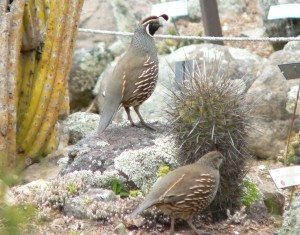
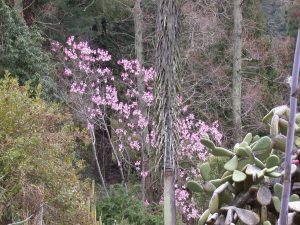
For most of its long history, the Garden was free. But since the University has drastically cut back on funding the Garden, an admission fee of $10 for adults and $8 for seniors is now charged. Of course, a better choice is to become a Garden member and come for free almost every day of the year. And be sure to stop by the Garden shop where there are a variety of publications and a deck full of plants for sale.
For date and details on the upcoming April 2013 “bird sit,” see the Golden Gate Bird Alliance field trips web page in March or early April.
About the UC Botanical Garden:
Location: 200 Centennial Drive, above the UC Berkeley campus.
Hours/Fees: The Garden is open from 9 until 5, except on holidays and the first Tuesday of each month. No entry after 4:30 p.m. Entrance fee of $10 adults, $8 seniors/students. Garden members, UC employees and UC students free. Please check the Garden web site for current hours and fees.
Habitat: Varied. The Garden is surrounded by woodland and coastal scrub, and several creeks run through it. Human-made habitats within the Garden include woodland, scrub or chaparral-like assemblages, and riparian zones.
Key Birds: Winter: Hermit Thrush, Ruby-crowned Kinglet, Red-breasted Sapsucker, Varied Thrush, various sparrows. Spring: Black-head Grosbeak, Warbling Vireo, Hooded Oriole. Year-round: Bewick’s Wren, Spotted Towhee, Anna’s Hummingbird, Stellar’s Jay, Dark-eyed Junco, California Thrasher, Wrentit, Song Sparrow, Lesser Goldfinch.
Ease of Access: Some large paths are paved but all secondary paths are gravel. Much of the Garden is steep terrain, although there are some wheelchair-accessible areas. Staff in the entry kiosk can help with access questions.
Getting There: UC offers a shuttle from the downtown Berkeley BART station, Monday-Friday. Driving directions and shuttle information are available on the Garden’s web site. Parking is available for a small fee in the UC Lot across from the Garden.
Nearby services: Restrooms and garden shop on site.
Nearby cafes/ restaurants: The closest cafe is at Lawrence Hall of Science. Otherwise, there are numerous eateries down the hill next to the main U.C. campus.
Guided walks: Check the calendar on the Garden’s website for the next quarterly bird walk.
For more information: See the Garden’s web site at http://botanicalgarden.berkeley.edu/, or call (510) 643-2755.

